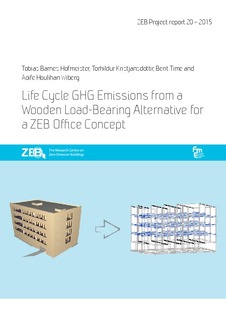| dc.contributor.author | Hofmeister, Tobias Barnes | |
| dc.contributor.author | Kristjansdottir, Torhildur | |
| dc.contributor.author | Time, Berit | |
| dc.contributor.author | Houlihan Wiberg, Aoife Anne Marie | |
| dc.date.accessioned | 2016-02-12T12:48:30Z | |
| dc.date.accessioned | 2016-02-18T06:24:47Z | |
| dc.date.available | 2016-02-12T12:48:30Z | |
| dc.date.available | 2016-02-18T06:24:47Z | |
| dc.date.issued | 2015 | |
| dc.identifier.isbn | 978-82-536-1440-3 | |
| dc.identifier.isbn | 978-82-536-1441-0 | |
| dc.identifier.issn | 1893-157X | |
| dc.identifier.issn | 1893-1561 | |
| dc.identifier.uri | http://hdl.handle.net/11250/2379419 | |
| dc.description.abstract | A major contributor to global greenhouse gas emissions is the production of concrete and steel for the construction industry. This report presents a comparison of the life cycle GHG impact of a concrete and steel load-bearing structure with a wood load-bearing alternative. The basis for the comparison is a theoretical ZEB office concept of a four story Norwegian office building.
The wooden structure causes approximately half the emissions of the concrete and steel structure. The results show that end-of-life emissions account for less than 10% of the overall GHG emissions from the load-bearing systems life cycle. | |
| dc.language.iso | eng | |
| dc.publisher | SINTEF Academic Press | |
| dc.relation.ispartofseries | ZEB Project report;20 | |
| dc.subject | Bearing structures | |
| dc.subject | Wood | |
| dc.subject | Concrete | |
| dc.subject | Steel | |
| dc.subject | Life cycle GHG emissions | |
| dc.subject | End-of-life scenarios | |
| dc.title | Life Cycle GHG Emissions from a Wooden Load-Bearing Alternative for a ZEB Office Concept | |
| dc.type | Research report | |
| dc.date.updated | 2016-02-12T12:48:30Z | |
| dc.description.version | publishedVersion | |
| dc.rights.holder | © 205 SINTEF Academic Press and Norwegian University of Science and Technology | |
| dc.subject.nsi | VDP::Technology: 500 | |
| dc.identifier.cristin | 1244742 | |
